Monthly e-News
Sign up for monthly e-news here!
See all monthly newsletters and annual reports here!
Latest News
Now Hiring: Project Manager II (Watershed Habitat Restoration and Fisheries Monitoring)
We are now hiring for a Project Manager II position specialized in Watershed Habitat Restoration and Fisheries Monitoring. To see the full job description and instruction on how to apply, click here.
Past News
2022 LandSmart Grazing Program for Community Resilience
It’s that time of year again! Local Resource Conservation Districts (RCDs) in Sonoma County have collaborated for a second year on the LandSmart®Grazing Program, and we are now accepting applications.
LandSmart®Grazing is a targeted grazing program designed to support interested neighbors or community groups to utilize grazing as a way of reducing fuel load and making their communities safer in the face of wildfires. In addition to reducing fire risks, this carbon friendly method of vegetation management, and community-supported targeted grazing, can improve biodiversity. This project also aims to serve previously burned properties in order to remove invasive weeds and reduce fuel load in preparation for future, post-fire recovery activities.
>> Click here to learn more and access our application
2021 LandSmart® Grazing Program for Community Resilience
 LandSmart® Grazing is a targeted grazing program designed to support interested neighbors or community groups to utilize grazing as a way of reducing fuel load and making their communities safer in the face of wildfires. This project also aims to serve previously burned properties in order to remove invasive weeds and reduce fuel load in preparation for future post-fire recovery activities. Learn more here.
LandSmart® Grazing is a targeted grazing program designed to support interested neighbors or community groups to utilize grazing as a way of reducing fuel load and making their communities safer in the face of wildfires. This project also aims to serve previously burned properties in order to remove invasive weeds and reduce fuel load in preparation for future post-fire recovery activities. Learn more here.
Now Accepting Applications for Directors
The Gold Ridge Resource Conservation District (District) is seeking interested parties to fill a vacancy for Director. If selected for Director, the term of office is through December 2022. Appointees may seek re-appointment when the term expires. This is a volunteer organization, and Directors are not financially compensated for service.
Applications are due by email, hand or mail delivery to the Gold Ridge RCD office by Friday, September 10th, 2021, 4pm. Please deliver your application to: [email protected] or Gold Ridge RCD, 2776 Sullivan Rd, Sebastopol, CA 95472 (please call for directions if hand-delivering your application).
Past News
January 2020
Upper Green Valley Creek Streamflow Improvement Plan 2020
Gold Ridge and partners are happy to announce the release of the Upper Green Valley Creek Streamflow Improvement Plan (SIP).
The purpose of the Upper Green Valley SIP is to identify specific measures to moderate the impact of dry season water demand and
improve instream flow for coho salmon and ecosystem function in the Upper Green Valley Creek watershed. Read more >>
December 2019
Healthy soils for small coastal dairies workshop
Tuesday, December 17, 2019
10am to 2pm (Lunch included)
Valley Ford, CA
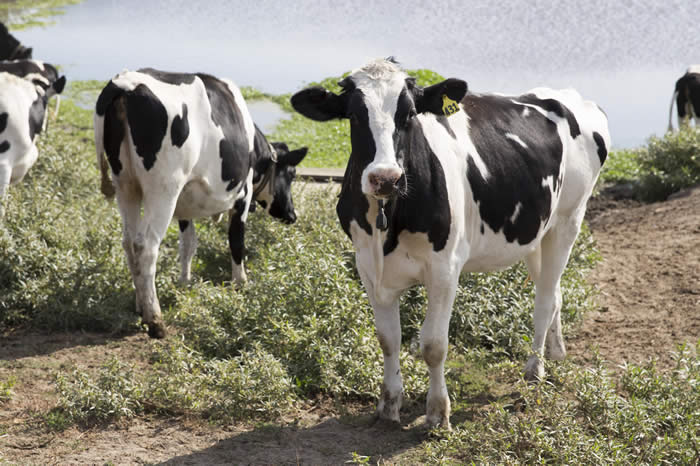 Are you interested in soil health on small coastal dairies? This workshop is intended for dairy producers, ranchers, agency partners, technical service providers and land stewards who are interested in learning more about the California Department of Food and Agriculture's Healthy Soils Program. Gold Ridge RCD received grant funding for a CDFA Healthy Soils Program demonstration project at the Ocean Breeze Dairy. The project is in its second year, and we will provide updates on the two carbon beneficial conservation practices being implemented: applying compost on 30.0 acres of grassland and installing two acres of riparian forest buffer. The workshop will take place at the dairy. Directions will be provided upon registration.
Are you interested in soil health on small coastal dairies? This workshop is intended for dairy producers, ranchers, agency partners, technical service providers and land stewards who are interested in learning more about the California Department of Food and Agriculture's Healthy Soils Program. Gold Ridge RCD received grant funding for a CDFA Healthy Soils Program demonstration project at the Ocean Breeze Dairy. The project is in its second year, and we will provide updates on the two carbon beneficial conservation practices being implemented: applying compost on 30.0 acres of grassland and installing two acres of riparian forest buffer. The workshop will take place at the dairy. Directions will be provided upon registration.
October 2019
Join us for the Valley Ford Schoolhouse Pie Auction on November 26th!


Please join us for the 2019 Valley Ford Schoolhouse Pie Auction, Tuesday, November 26th 5:30 pm at 14355 School Rd, Valley Ford, CA 94972 to raise funds to repair our community building.
The Valley Ford Schoolhouse is a historic building and the only community building in town. Serving as a one-room schoolhouse until the mid-1960’s it has most recently been the venue for community gatherings, family celebrations, classes and fundraisers. This building means a lot to Valley Ford. The Schoolhouse is in need of repairs and upgrades to ensure it can continue to hold space for laughter, ideas and reminiscing for another 100 years. Please help the Schoolhouse by coming out for the folksy, welcoming, and sometimes hilarious Pie Auction.
The Pie Auction is a favorite community tradition that is back after a 5 year break. It’s a live auction to purchase your Thanksgiving pies from local celebrities like my husband’s Nana who uses apples from a 150yr old apple tree, your old 3rd grade teacher or favorite neighbor. There will be free Comet Corn Popcorn, simple delicious fare and beverages for purchase, live music and lots of local color. Plus, this year the schoolhouse will feature music by Sonoma County’s own Burnside Band, art by local youth, local hot apple cider, homemade decorations, and lots of good surprises.
Want to talk about the event or pies? Just contact Brittany Jensen, Executive Director, Gold Ridge RCD: [email protected] or call (707) 823-5244.
So come on down for the 2019 Valley Ford Schoolhouse Pie Auction! I hope to see you there.
-Brittany Jensen, Executive Director, Gold Ridge RCD

Gabriel Farm studies on-farm carbon sequestration with Healthy Soils Program Demonstration Project
July 2019
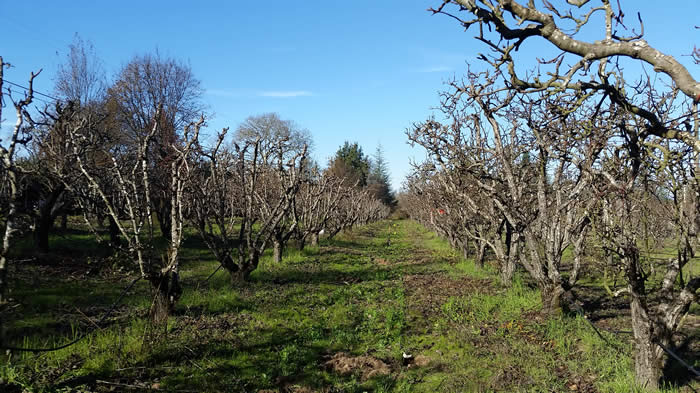 Torrey and Lucy Olson have always been innovators. Twenty-five years ago, Lucy attended UC Santa Cruz to study organic farming at the Center for Agroecology & Sustainable Food Systems. As she learned about how important nutritious food is to communities and about the positive ecological impacts that organic, diversified farms can have on the landscape, Lucy became convinced that farms could be an impressive force for good. When she and Torrey Olson made the move to purchase and operate Gabriel Farm in 2000, it was a declaration of their commitment to “farming the good” in Sebastopol.
Torrey and Lucy Olson have always been innovators. Twenty-five years ago, Lucy attended UC Santa Cruz to study organic farming at the Center for Agroecology & Sustainable Food Systems. As she learned about how important nutritious food is to communities and about the positive ecological impacts that organic, diversified farms can have on the landscape, Lucy became convinced that farms could be an impressive force for good. When she and Torrey Olson made the move to purchase and operate Gabriel Farm in 2000, it was a declaration of their commitment to “farming the good” in Sebastopol.
Today, Gabriel Farm, a 14-acre family farm located near Graton, grows nine acres of Asian Pears, two acres of Certified Organic Apples, and various other organic crops including: Persimmons, Raspberries, Pluots, Tomatoes, Pineapple Guavas, Blackberries, Lavender, Pumpkins and Winters Squash. Each fall, the Olsons open their farm to people who want to share the farming experience with their family and friends. Members of the U-Pick membership program bring baskets and blankets to pick the fall’s bounty and sit enjoy a locally grown lunch. (To learn more about the program, visit: https://www.gabrielfarm.com/)
But still, Torrey and Lucy felt there was room to do more on Gabriel Farm. When Torrey, a Board member for the Gold Ridge RCD, learned about a program of the CA Dept of Food and Agriculture (CDFA) that supports farmers in demonstrating practices that enhance their farm’s soil health to combat climate change, he was interested. Working together, the RCD and Torrey applied for and received funding from the CDFA’s Healthy Soils Program to demonstrate an innovative approach to managing the orchard floor. In organic farming systems, tillage is often utilized in the rows for weed suppression. However, this practice has negative consequences that can include the loss of soil structure, accelerated decomposition of organic matter, reduction in infiltration rates, and increased susceptibility to water and wind erosion. And when the soil’s health is in decline, it is unable to be the incredible carbon-holding sponge that it can be, holding down literally tons of carbon that once resided in the atmosphere as the greenhouse gas carbon dioxide.
On a mission to bring that soil carbon-sponge to life, Lucy, Torrey and the project partners will be working to test two practices: first mulching with woodchips as a weed control, then inoculating the soil with actively aerated compost tea to improve soil health. Those project partners, including Gold Ridge RCD, Carbon Cycle Institute, San Francisco State University and Intuit Ag, have three years to test the effects of actively aerated compost tea and woodchip-based mulch application on greenhouse gas emissions, soil carbon sequestration and weed suppression at Gabriel Farm.
How exactly will they know if it is doing any good? Everything they do will be compared with the current floor management practice, which is to disc the rows every fall and spring. These rows will be the control. In the test rows, three treatments will be implemented for comparison. One set of rows will be disked and get an application of compost tea. Another set of rows will not be disked for weed suppression, but instead get a thick 6-inch application of woodchip mulch. And a third set of rows will not be disked but will get the mulch and compost tea treatment together. By taking soil samples and gas exchange samples from all four sets of treatments, the project partners will test for total organic carbon, soil organic matter, bulk density, infiltration rates, and CO2, CH4 and N2O flux between the orchard soil and the atmosphere. These soil health indicators will be studied to determine which treatments are working well to enhance Gabriel Farm’s soils.
Along the way, Torrey and Lucy plan to share their progress with others. While Gabriel Farm is small compared to other agricultural producers in the state, small orchards are the norm in the North Coast region. The “demonstration” part of the project means that what the Olsons do on Gabriel Farm is demonstrated to farmers across the region. Producers from the Ukiah Valley to Kelseyville will be invited to observe the trial's results at public workshops.
If you have questions about this project, please contact William Hart at 707-823-5244 or [email protected] for more information.

Camp Meeker partners with RCD on Community Wildfire Protection Plan
May 2019
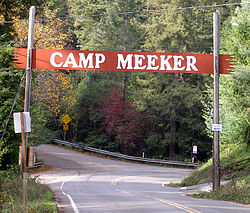 It was mid-October 2018--just around the time of the first anniversary of the Tubbs Fire--when Richard Seaman surveyed his Camp Meeker community's interest in "restoring the forest and making Camp Meeker fire-safe" through a petition. From a community of 348 households, his petition received about 250 supporting signatures. Through his outreach campaign, Richard met allies who would quickly become the first members of Fire Safe Camp Meeker, a community group focused on educating, planning and implementing activities in Camp Meeker that will make the forested hill-side neighborhood more resilient to future wildfires.
It was mid-October 2018--just around the time of the first anniversary of the Tubbs Fire--when Richard Seaman surveyed his Camp Meeker community's interest in "restoring the forest and making Camp Meeker fire-safe" through a petition. From a community of 348 households, his petition received about 250 supporting signatures. Through his outreach campaign, Richard met allies who would quickly become the first members of Fire Safe Camp Meeker, a community group focused on educating, planning and implementing activities in Camp Meeker that will make the forested hill-side neighborhood more resilient to future wildfires.
Fire Safe Camp Meeker members reached out to local agencies, including Gold Ridge RCD and Fire Safe Sonoma, for funding and technical assistance. In November, the three organizations partnered with the North Coast Resource Conservation and Development Council on a funding proposal to the California Department of Forestry and Fire Protection, also known as CAL FIRE, for the creation of a Community Wildfire Protection Plan (CWPP), and received funding in May.
The Community Wildfire Protection Plan is a collaborative effort that requires input from all stakeholders, including Camp Meeker residents, local businesses, retreat camps and the relevant fire and natural resources agencies. Together, we will hold community meetings to gather information about Camp Meeker's vulnerabilities to wildfire and then prioritize projects that have earned the greatest stakeholder interest.
Projects might include: home-hardening activities, forest and roadside vegetation management, defensible space creation, improving first-responder access and evacuation routes, developing an community evacuation plan, improving road and address signage throughout the community, and more.
When it comes time to put the plan into action, projects will be implemented by volunteer community members and hopefully with additional funding from agencies like CAL FIRE. Donations are also a significant help to these projects. Consider making a donation today.

Storm Damage Data Collection and Assistance
March 2019
Heavy rainfall and flooding that occurred in late February have impacted our community in numerous ways. If you were impacted, please review the following information on potential resources, or pass it along to anyone you know who may need such assistance.
The Gold Ridge and Sonoma Resource Conservation Districts (RCDs) are working with the County of Sonoma to document damage to private properties (both residential and commercial) that were affected by streambank erosion and slope failure triggered by the February 2019 storm event. The USDA Natural Resources Conservation Service (NRCS) may be able to provide technical advice and/or financial assistance for landowners to address these impacts if they are determined to be a threat to life or property. Documentation of damage is the first necessary step. The RCDs are collecting initial documentation of property damage from landowners and submitting it to NRCS who will assess whether they may be able to assist. NRCS will then conduct site visits with RCD staff.
Submit information about erosion-related storm impacts to your property HERE
Submissions are due Friday April 5, 2019 / Download the Storm Damage Assistance Flyer
If you are not sure which RCD area covers your property, you may contact either RCD and we will make sure your information gets to the right place!
Please Note: This is not a program to assist with damage to homes from flood waters (e.g. mud or debris inside homes, damaged sheetrock or appliances, etc.). For more information and resources for damage to homes, please visit https://socoemergency.org/ and look for “2019 Russian River Flood Recovery Information,” or click: https://socoemergency.org/home/recover/2019-flood/
For Further Information, please contact either RCD at:
Gold Ridge RCD
Jason Hoorn
Program Manager
707-823-5244
Sonoma RCD
Aaron Fairbrook
Program Manager
707-569-1448 x106

Neighbors to Atascadero Creek are essential to the success of a new watershed study
March 2019
The Gold Ridge RCD is seeking the partnership of landowners to assist in a study of the Atascadero Creek subwatershed. This creek has become the focus of our study because of its potential to provide excellent habitat for the endangered coho salmon.
Residents can help by sharing their stories about how the creek has changed over time and by providing the research team with access to the creek via their property.

Valley Ford dairy demonstrates carbon farming solution to an international audience
September 2018
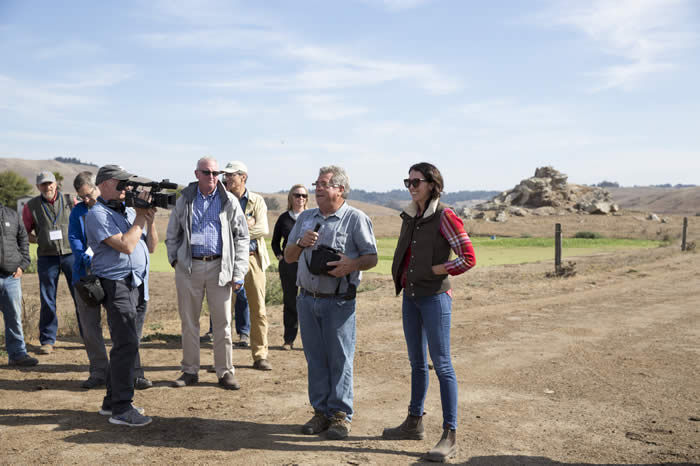 This September, Governor Jerry Brown held an international event in San Francisco to bring attention and renew commitment to solutions to the climate crisis. The Global Climate Action Summit touched on all sectors of society that send greenhouse gas emissions into the air. The California Department of Food and Agriculture hosted a two-day affiliate event in Sonoma County to highlight the role that working lands play in reversing the emissions of harmful greenhouse gases.
This September, Governor Jerry Brown held an international event in San Francisco to bring attention and renew commitment to solutions to the climate crisis. The Global Climate Action Summit touched on all sectors of society that send greenhouse gas emissions into the air. The California Department of Food and Agriculture hosted a two-day affiliate event in Sonoma County to highlight the role that working lands play in reversing the emissions of harmful greenhouse gases.
In the first day, agricultural producers, business leaders and policy makers from around the world gathered at La Crema Estate at Saralee's Vineyard in Windsor. Attendees learned about the need to scale up climate smart agricultural practices that cut greenhouse gas emissions, capture carbon from the atmosphere, and store it in the soil. Scaling up means that farmers and ranchers need partnership, investment, research and technical assistance to achieve the climate goals that the global community has established. In the words of the Secretary of California Department of Agriculture, Karen Ross: “These collaborations are essential for progress, and they must cut across the food chain, all the way from farms to consumers.”
Partnerships were on display for day two of the event when attendees traveled to the coast to visit Ocean Breeze Dairy in Valley Ford and Stemple Creek Ranch in Tomales, CA. Ocean Breeze Dairy and the Gary Bordessa Dairy make up the multi-generational Bordessa Family Dairy, whose business model focuses on grass-fed, certified organic milk production. Jarrid and Jackie Bordessa, owners of Ocean Breeze Dairy, have decided to take their commitment to the land another step further. They recently partnered with the Gold Ridge RCD and the Carbon Cycle Institute to write a Carbon Farm Plan, a guiding document to managing carbon resources.
Changes to the Bordessa’s operation—like applying compost, planting vegetation along the creeks, and alternative manure management practices—can remove carbon from the atmosphere where it can do harm warming the planet and build carbon stores in the soil and in vegetation. These practices also provide multiple benefits to the dairy operation as they advance soil health, improve riparian habitat, increase range production and boost soil water holding capacity.
Organic Valley, the dairy company that Ocean Breeze Dairy sells its milk to, also has their focus on climate. At the affiliate event, Organic Valley announced the company’s deepened commitment to climate smart agriculture. “As leaders in food and farming, it is our responsibility to pioneer change for good,” says Jonathan Reinbold, the company’s head of sustainability. Committed to being part of the climate solution, Organic Valley, in partnership with Annie’s Organics, has already financed the development of three Carbon Farm Plans in Sonoma and Mendocino Counties, but in 2018, this initiative will be expanded to other California farmers. From there, Organic Valley can explore how to bring Carbon Farm Planning to their other farmers across the country.
Carbon Farm planning and implementation funding provided by USDA’s NRCS Regional Conservation Partnership Program and CDFA’s Healthy Soils Initiative.
Top right: Ocean Breeze Dairy is featured at the "Scaling Up Climate Smart Agriculture" affiliate event to the Global Climate Action Summit on September 12, 2018. Photo credit: Isabel French Photography
Below left: Compost produced at a neighboring ranch has been heated and is ready to be spread one half-inch thick onto select pastures at Ocean Breeze Dairy. Photo credit: Isabel French Photography
Below right: Holstein dairy cattle will trample the applied compost into the soil, feeding soil microbes and activating the carbon cycle. Photo credit: Isabel French Photography
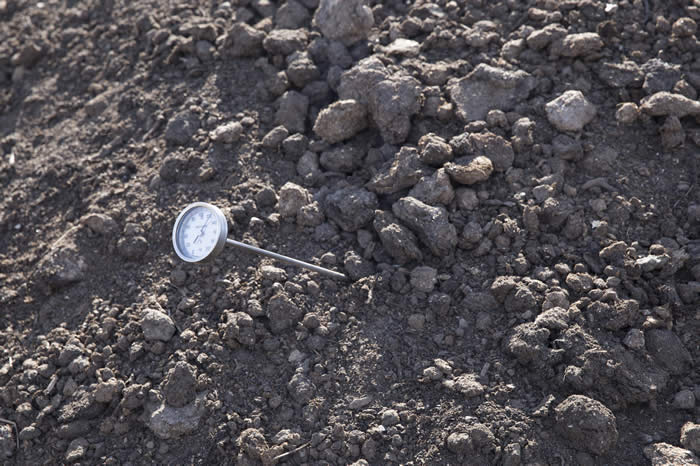
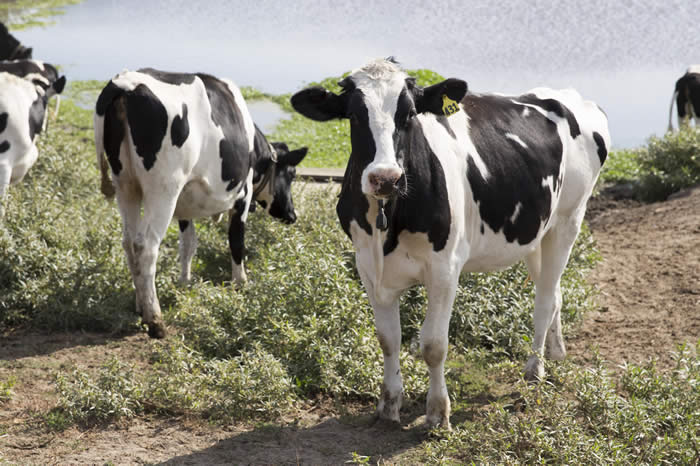

Cider Apple Farm Revives Heirloom Orchard and Plans for a Changing Future
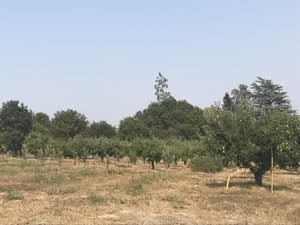
On Wednesday, August 8, members of the apple farming community gathered in Sebastopol around a vanguard in the local movement for innovative orchard management: Apple Bottom Farm.
Ned Lawton, owner of Apple Bottom Farm and Founder of Ethic Ciders, was excited to greet the group of 45 or so attendees at the Farmer-to-Farmer Field Day event organized by the Farmers Guild. The attendees, many of whom were either apple farmers or cider industry professionals, were eager to hear from Apple Bottom Farm’s team about their explorations of climate-adapted cider apple varieties. The management team strives for “farming as stewardship.” This effort is supported by a carbon farm plan, recently completed in partnership with the Gold Ridge RCD.
Lawton explained that behind the efforts at Apple Bottom Farm is his mission to keep Sonoma County apple agriculture alive and thriving. He recognized that in order to do so, their farm would need to produce something truly significant. The result: local, sustainable, exquisite cider. Lawton and his wife are first-generation farmers with a desire to bring their family and friends closer to nature. In 2015, two years after the purchase of the two-and-a-half-acre organic heirloom apple farm, a cidery emerged. Ethic Ciders, a cidery “rooted in relationship to the land,” was born. Ned and his wife Michele Lawton felt that delicious cider would be the avenue for revitalizing both the apple orchard itself and their community’s relationship to the land.

Soil Health in North Coast Gets Big Boost from National Conservation Innovation Grant Award
August 2018
On July 26, the USDA Natural Resources Conservation Service (NRCS) announced that Napa County Resource Conservation District (RCD), Gold Ridge RCD, Mendocino RCD, and Sonoma RCD, partners in the North Coast Soil Health Hub (SoilHub.org), were one of 22 groups in the nation to be awarded the agency’s Conservation Innovation Grant. The highly competitive award will bring $389,432 to the North Coast of California. Funds will support the growth of the Soil Health Hub and associated outreach to grape growers about the fundamentals of soil health, practices that impact soil health, and the role of soil health in enhanced crop production and as a solution for the region’s resource concerns, such as drought and water quality. The Conservation Innovation Grant funds will be matched dollar for dollar by local funds secured by the RCDs.
The funding will allow the RCDs to continue offering their current soil health assessment service to growers and monitoring regional vineyard soil health demonstrations. Additionally, the funding will allow the RCDs to work with University of Oregon to develop a regionally specific tool to aid interpretation of soil health assessment results for California’s North Coast vineyards. At the end of the project, RCDs and growers will have a better understanding of which soil management practices have the greatest potential to improve soil health and vineyard productivity.
Across the nation, USDA awarded more than $10.6 million to 22 projects through the Conservation Innovation Grant program to address three priorities: grazing lands, organic agriculture systems, and soil health. “Through our Conservation Innovation Grants, we are able to bring together a wide array of groups to drive innovation and spur cutting-edge projects,” said Bill Northey, USDA Undersecretary for Farm Production and Conservation. “This year’s competition resulted in an impressive array of proposals that will ultimately benefit the people who grow our food and fiber.”
See the full list of this year’s Conservation Innovation Grant projects.

Sonoma & Gold Ridge RCDs Add Forester to the Team
July 2018
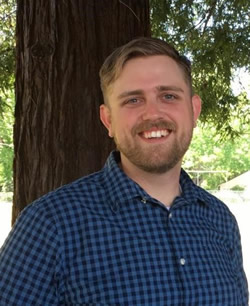 The Sonoma and Gold Ridge RCDs recently jointly hired a forester to serve the entire county of Sonoma. The following article is from Sonoma RCD's June newsletter.
The Sonoma and Gold Ridge RCDs recently jointly hired a forester to serve the entire county of Sonoma. The following article is from Sonoma RCD's June newsletter.
The RCD is excited to welcome Jason Wells, a Registered Professional Forester (RPF), to our staff team. Since the wildfires of October 2017, it has become increasingly apparent that the landowners and communities of Sonoma County need more resources to assist with forest and fuel load management. The Sonoma and Gold Ridge RCDs teamed up to garner funding from the USDA Natural Resources Conservation Service, through the National Association of Conservation Districts, to launch a new position focused providing on forestry technical assistance.
Jason Wells, a California Registered Professional Forester (RPF), comes to us with six years of experience in private industry throughout Humboldt and Mendocino Counties. His experience includes writing CEQA equivalent Timber Harvest Plan documents, integrating knowledge of forest operations with environmental impact mitigations, silviculture (applied forest ecology), forest health and protection, economics of forest management, and road design and layout. Jason has also been certified by the California Department of Forestry and Fire Protection (CALFIRE) to conduct archaeological surveys for plans in which CALFIRE is lead agency. Born and raised in Petaluma, he graduated from Humboldt State University with a B.S. in Forestry with an emphasis in Forest Conservation.
At the RCD, Jason will provide technical and planning assistance to landowners, help build a forestry program capable of addressing vegetation and fuels management concerns throughout the county, as well as address post-fire recovery efforts. If you are an owner of forestland in Sonoma County with questions about forest management, Jason would love to hear from you! He can provide as-needed technical advice, forest management planning, and will also be looking to identify potential forest management and fuel load reduction projects for future grant funding. Jason can be reached at 707-569-1448 x107, or [email protected].

Ombudsman Hired to Assist Septic Owners and Operators in Lower River Communities
May 2018
 In partnership with the County of Sonoma, the Gold Ridge and Sonoma Resource Conservation Districts have hired an ombudsman to provide residents of the lower Russian River with assistance and support regarding changing septic system regulations.
In partnership with the County of Sonoma, the Gold Ridge and Sonoma Resource Conservation Districts have hired an ombudsman to provide residents of the lower Russian River with assistance and support regarding changing septic system regulations.
Septic systems, also known as Onsite Wastewater Treatment Systems (OWTS), have been in the news quite a bit lately. In order to combat pathogen pollution concerns, State policies have been updated and County standards for OWTS are being revised. These revisions will change the way OWTS are regulated in Sonoma County, and you may be wondering how the changes will affect you. While the regulations are still evolving, neighborhoods and communities in the lower Russian River area will be affected in the not-too-distant future. In the meantime, making sense of all the laws, manuals and acronyms is no easy task – and for the many residents who depend on OWTS, it can be hard to know where to start. To that end, there is now a resource that is dedicated to providing communities with resources and support regarding the OWTS issue.
David Wood was recently hired as the Lower Russian River Ombudsman. Ombudsmen are hired to work in a variety of institutions – from governmental to educational to private organizations – but their essential function is to provide unbiased assistance to individuals with concerns about a specific issue. As a non-regulatory, informational resource, David’s job is to assist residents of the lower Russian River area with OTWS related issues. Specifically, David can help with questions about regulations, provide confidential information to residents about their septic systems and identify grants and other financial assistance opportunities to help them with upgrades or improvements. David will also be tracking other issues related to water quality in the lower Russian River, so that he can help interested residents learn more about how OWTS fit into the larger picture. If you live in the lower Russian River area, David can help. Russian River Ombudsman >>
David can be reached by phone at 707-806-4723 or by email at [email protected]. He has drop-in office hours on Wednesdays between 3:00pm and 7:00pm, and on Thursdays between 9:00am and 12:00pm. He is available on other business days and Saturdays by appointment and will be attending local meetings and community events related to this issue. His office is located at 9925 Main Street, Monte Rio, CA 95462, next to the Monte Rio Amphitheater. If you have an upcoming community event or neighborhood meeting that you would like David to attend, please contact him.

Plant Oaks on Your Property
January 2018
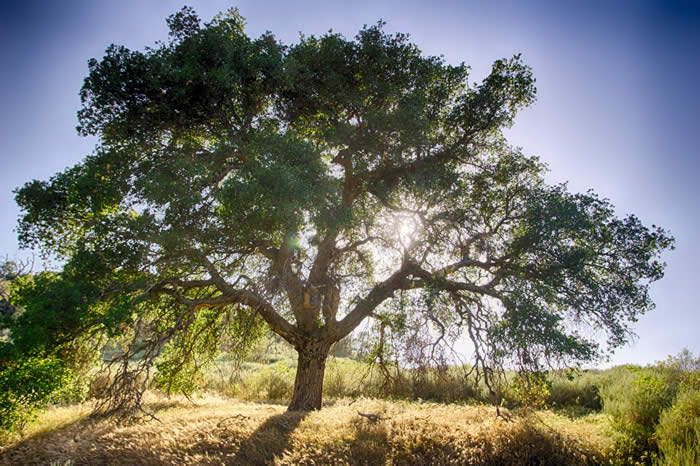 The California Native Plant Society has collected hundreds of acorns from across the county this past fall. They are partnering with local organizations like the Sonoma and Gold Ridge RCDs to get area-specific acorns and oak seedlings planted by local landowners.
The California Native Plant Society has collected hundreds of acorns from across the county this past fall. They are partnering with local organizations like the Sonoma and Gold Ridge RCDs to get area-specific acorns and oak seedlings planted by local landowners.
Why Plant Oaks? This effort to promote oaks was inspired by the loss of oak trees during the October fires. However, the consortium of organizations working together to promote oak planting sees a value beyond simply replacing lost oaks: newly planted oaks can also be part of an effort to enhance existing and historic oak woodland, to help return landscapes to the native ecology, and to plant “legacy” trees that will be here for our families and community far into the future.
Direct-Seed Acorns: Acorns are being kept in cold storage, and many species are ready to be planted this winter. Receive acorn species that match your area.
Plant Seedlings: Several local nurseries are propagating oaks into seedlings. These seedlings will be available to landowners by Fall 2018.
Instructions: Advice for planting and protecting oaks can be found from our partner, Napa County RCD online here. And here from the CA Dept of Forestry.
Contact Us: If you would like to plant acorns or oak seedlings on your property, please contact Adriana at [email protected] or call (707) 823-5244.
Headlines in Healthy Soils News
August 2017
Healthy Soils Program Seeks Farmers to Apply for Funding
California’s much-anticipated Healthy Soils Program officially launched August 8 with the release of the first Request for Grant Applications (RGA) by the California Department of Agriculture (CDFA). The deadline for applications is 5pm on September 19th. The first of its kind in the country, the program will provide grants to farmers and ranchers for implementing on-farm practices that reduce greenhouse gas emissions and/or store carbon in soil, trees and shrubs. Types of practices that will be eligible include the addition of mulch and compost, cover cropping, reduced tillage, and the planting of herbaceous and woody plants such as windbreaks, hedgerows, riparian plantings, filter strips, silvopasture and more.
New Soil Health Hub Supports Climate Beneficial Practices in North Bay
This year, RCDs from Sonoma, Napa and Mendocino County, NRCS, UC Research and Extension Centers and other partners collaborated as the North Coast Soil Health Hub with funding from the CDFA Specialty Crop Block Grant to create an information-sharing network that would support farmers in improving their soil health. The network is currently laying the groundwork for soil health demonstrations, workshops with industry specialists, farmer-to-farmer forum discussions, an online resource library and more. The RCDs invite farmers to access and contribute to resources and discussions online at the North Coast Soil Health Hub.
Attention Grapegrowers: RCD Needs Your Input on Soil Health
Vineyard Soil Health Survey
For vineyards in the North Coast region of CA, what does soil health mean? Gold Ridge RCD, along with the regional RCDs, NRCS, and others, are in the early stages of a grant-funded project to generate discussion, demos, and science on soil health and soil carbon as it relates to vineyards in our region.The survey is the first step in understanding what climate beneficial practices can be expanded on our region's vineyards. Please take this survey to tell us what types of soil health practices are being used (e.g. cover crop, compost application), what types of soil health practices are difficult to implement, and what types of soil health practices grapegrowers are curious to learn more about. In the next year, the regional RCDs will be setting up 3 soil health demo sites in Napa Valley, hosting workshops, and offering free soil health assessments to growers. Stay posted on these efforts via the new North Coast Soil Health Hub website.
Gold Ridge RCD and the Santa Rosa Plain Groundwater Sustainability Agency
May 2017
In 2014, the state of California adopted The Sustainable Groundwater Management Act of 2014 ("the Act" or "SGMA"). While the Act is a complex piece of legislation, its primary goals are:
• To ensure that the significant groundwater basins in California (those designated as high and medium priority by the Department of Water Resources) are "sustainably managed,"
• To provide local groundwater agencies with the authority and the technical and financial assistance necessary to sustainably manage groundwater.
To achieve its stated goal of sustainability, the Act requires that Groundwater Sustainability Agencies ("GSAs") be in place in each significant basin by June 30, 2017. The GSAs are then required to adopt Groundwater Sustainability Plans ("GSPs") by January 31, 2022.
There are three medium priority basins in Sonoma County: the Petaluma Basin, the Santa Rosa Plain Basin and the Sonoma Valley Basin.
Why is Gold Ridge RCD involved?
At our April 20, 2017 board meeting our Board of Directors approved our involvement as a voting member for the Santa Rosa Plain Basin GSA, the only medium priority basin within our district. The RCD is not required to be involved in the local GSAs. We have been hearing from our community that they want the RCD to help represent the ideas and needs of well owners in the Santa Rosa Plain. We have taken very seriously our decision to participate and the investment in time and money that is required to do so.
We chose to be involved for two key reasons:
1. We believe that our work over the last 75 years working closely with hundreds of groundwater users gives us an understanding of their issues and concerns. We can be a voice for those concerns on the governing board of the GSA.
2. We believe that we are part of the solution to effective groundwater management. We are focused on working with local landowners, using a science-based approach, and advocating for voluntary approaches to key aspects of the implementation of future Groundwater Sustainability Plans. Our experience in implementing on the ground conservation projects, monitoring groundwater levels, and working with local communities aligns us to help implement future solutions to potential groundwater issues. The RCD can effectively bridge environmental concerns with the pragmatic needs of groundwater users.
Have your voice be heard:
We know there is concern in the community about the formation of the GSAs and many of the unknowns, including future potential regulations and fees. We encourage you to get involved in future groundwater sustainability agencies by attending a future board meeting. We will continue to listen to community concerns at the RCD, and work to represent your vital interests.
Listening Sessions
May 18, 2017 | 5:40pm | Gold Ridge RCD Office
You can share your comments, ideas and concerns at our first listening session, scheduled for May 18, 2017 at 5:40pm at the Gold Ridge RCD office, directly after our monthly Board of Directors meeting. We will continue to listen to community concerns at the RCD, and work to represent your vital interests. You can also email your thoughts to [email protected].
Apply to the Gold Ridge RCD Appointee to the Santa Rosa Plain GSA Advisory Committee
Applications due June 23, 2017
The Gold Ridge Resource Conservation District (RCD) has the ability to appoint one member to the Santa Rosa Plain Groundwater Sustainability Agency (SRPGSA) Advisory Committee. The Gold Ridge RCD would like to appoint a groundwater user within our District who is reliant on and knowledgeable of groundwater in the Santa Rosa Plain Basin. If no applicants are suitable, the Board may appoint one of the RCD staff to serve in this role; however, it is the preference of the RCD that a community member to take this seat. Click to apply.
Apply to the SRPGSA's Seven Interest-Based Seats
There will also be an opportunity to apply directly to the SRPGSA for the seven interest-based seats to be announced after the first SRPGSA Board Meeting on June 1, 2017.
For more information on upcoming GSA meetings and additional information go to: www.sonomacountygroundwater.org
Are You In An Affected Groundwater Basin? There is a tool on the California Department of Water Resources website that can help you determine the basin where your property is located. Go to https://gis.water.ca.gov/app/gicima/.
For resources on conditions of groundwater in your basins go to:
Santa Rosa Plain: http://www.scwa.ca.gov/srgroundwater/
Sonoma Valley: http://www.scwa.ca.gov/svgroundwater/
Petaluma: https://ca.water.usgs.gov/projects/2012-02.html
Groundwater Basin Maps
The three basins immediately affected by SGMA are below. Clicking each link will provide a detailed map of the groundwater basin:
Santa Rosa Plain/Santa Rosa Valley
Petaluma Valley
Sonoma Valley

Fallen Wood in the Creek
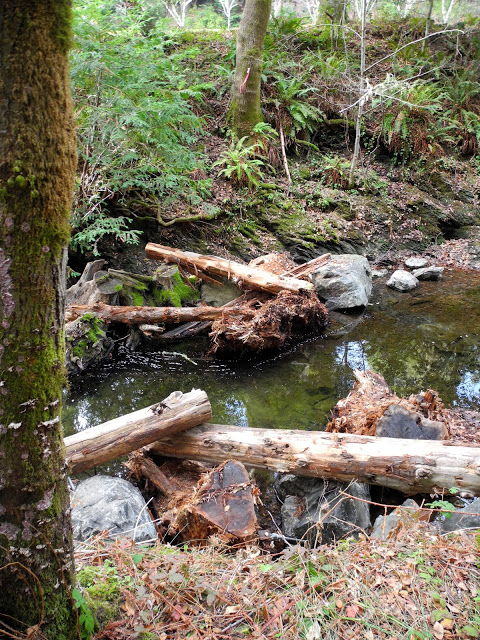 March 2017
March 2017
Why Leave Fallen Wood? Any strong storm can bring down trees, but after four years of drought, this winter we are seeing an especially large number of trees come down. It’s important to know that when trees fall into creeks, they become part of the creek channel in the eyes of the Department of Fish and Wildlife. Fallen trees, as they sit, tumble and turn within the creek, are nature’s creek-architects: they shape the creek’s bed and banks, the way the creek meanders, and how sediment and floating wood debris within the creek move or accumulate; fallen wood also becomes home and shelter to a variety of aquatic wildlife, and in particular, salmon and steelhead.
What About Removal? Large wood is critical to the health of a creek for these reasons, but in some cases, it can conflict with the needs of the creekside landowner. Large fallen wood can sometimes divert the stream’s energy toward a bank, posing a threat of bank failure or other damage, or may have caused serious damage at the time it fell. These might be reasons why a landowner would feel the need to remove fallen wood that lies within a creek channel.
Permitting: If you do need to remove wood from a stream, you first need to notify the Department of Fish and Wildlife by filing for a Lake or Streambed Alteration (1600 LSA) permit. As mentioned above, wood changes the creek’s bed and banks when it falls in; by removing it, a landowner is also causing change. The Gold Ridge RCD can assist landowners in filling out a 1600 LSA permit.
For landowners who encounter an emergency need to remove fallen wood, they have 14 days after the removal to file an Emergency 1600 LSA permit notification. Please read the instructions for this permit closely to be sure your situation qualifies as an emergency.
Before You Remove Wood...Take notice of any large wood situated in your creek. Some pieces of wood are part of structures that have been installed and secured to improve fish habitat by the RCD. If you are removing fallen wood, please do not remove these structures or other pieces of wood that pose no threat to property. Above is a photo of one of the RCD’s many large wood debris installation projects.
Learn more about the habitat and watershed benefits of fallen wood in our creeks.

Got Runoff? RCD Hosts Stormwater Workshop for Local Residents
 Wednesday, March 15th, 6-8pm
Wednesday, March 15th, 6-8pm
Apple Blossom School, 700 Watertrough Rd, Sebastopol, CA 95472
Free to the public
The copious rain delivered by recent storms is a drastic change after five consecutive years of drought, and the soil is beyond saturated! We understand that it is hard to manage lots of water and so in response have put together a workshop to offer ideas on how to manage winter runoff.
How can we make the most of rain, protect soil from erosion and landslides, prevent potholes, increase infiltration to water tables and prepare for future drought? Join Gold Ridge and Sonoma RCDs and partners for a tradeshow-style workshop that explains good water stewardship practices.
You will have access to experts and information on where to get the tools or help you need. We'll cover a suite of projects that store, slow, spread and sink stormwater, including rainwater catchment, permeable paving, rain gardens, earth works, and more. Bring your questions, ideas, and concerns about managing water on your property. We hope to see you there!
Presenters: Gold Ridge RCD, Harmony Farm Supply, Permaculture Artisans, Sonoma Master Gardeners, Daily Acts
BONUS! Attend a tour of Permaculture Artisans’ stormwater-wise demonstration projects, Saturday, March 18th, 10am-12pm. RSVP: Call Sebastian Bertsch at (707) 824-0836. Permaculture Skills Center is located at 2185 Gravenstein Hwy S, Sebastopol, CA 95472
Want to learn more? Read the Slow It, Spread It, Sink It, Store It! guide to stormwater management and others online. Go to http://goldridgercd.org/htm/water-stewardship-guides.htm

Emergency Meeting Addresses Green Valley Road Flooding
February 2017
Gold Ridge RCD has been working with the community to identify a solution to the chronic flooding of Green Valley Creek across Green Valley Road just outside Graton, CA. Local organizations have conducted and presented studies of the causes of flooding and potential short- and long-term solutions. Due to the severity of this year’s wet weather, the rate of sedimentation has increased to the point where most of the water in Green Valley Creek is going across the road, and the creek is abandoning is existing channel and establishing a new channel through the vineyard. The Sonoma County Water Agency, which is responsible for flood control, has determined that immediate action is required. An emergency meeting on February 10th, hosted by Gold Ridge RCD, updated residents on the situation and heard their concerns. Read more about the issue here.

New Video: The Making of the Salmon Creek Dairy Water Conservation Project
January 2017
NEW VIDEO - We are pleased to share a new video that shows the teamwork and mission around the 2015-2016 Salmon Creek Dairy Water Conservation Project -- a 1.4 million gallon rainwater harvesting system that conserves water for agricultural use and the wildlife of Bodega, CA.
Big thanks to our project partners: North Coast Resource Conservation & Development Council, California Department of Fish and Wildlife, California State Coastal Conservancy, U.S. Department of Agriculture, North Coast Resources Partnership through the California Department of Water Resources, Prunuske Chatham, Inc., Schaefer Engineering, Inc., Salmon Creek Watershed Council, Richard and Marilyn Hughes and Straus Family Creamery.

North Bay RCDs and Partners Plan for Climate Change on Vineyards
November 2016
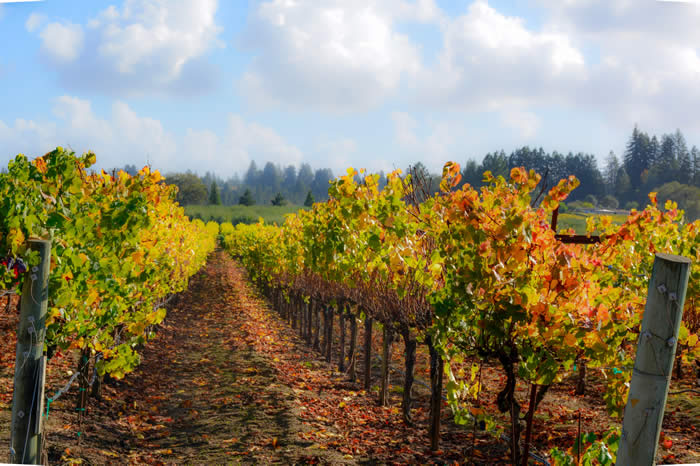 Hosted at the beautiful SRJC Shone Farm, the Gold Ridge, Sonoma, Mendocino and Napa RCDs, the USDA's NRCS Ukiah Office, UCCE Mendocino and the Santa Rosa Junior College came together this November to discuss current research on vineyard climate-beneficial practices for our region.
Hosted at the beautiful SRJC Shone Farm, the Gold Ridge, Sonoma, Mendocino and Napa RCDs, the USDA's NRCS Ukiah Office, UCCE Mendocino and the Santa Rosa Junior College came together this November to discuss current research on vineyard climate-beneficial practices for our region.
These might include timed irrigation/fertigation to increase nitrogen uptake by vines, compost application, hedgerow planting, cover cropping and grazing, reduced an non-tillage, and more. These practices are being examined for their ability to sequester carbon dioxide, retain water, reduce the need for synthetic fertilizers, amendments and pesticides, and maintain grape quality and quantity. This meeting will help inform the RCDs as they start assisting vineyards to create LandSmart Carbon Farm Plans.

RCD Hosts Public Meeting Regarding Flooding on Green Valley Road
November 2016
Gold Ridge RCD has been working with the community to identify a solution to the chronic flooding of Green Valley Creek across Green Valley Road just outside Graton, CA. Local organizations have conducted and presented studies of the causes of flooding and potential short- and long-term solutions. Gold Ridge RCD will not be funding or managing flood mitigation projects; instead, it has played a role in facilitating the research and development of mitigation solutions.
A public meeting was held November 17th, 5:30-6:45pm at the Oak Grove Elementary School Gymnasium. This meeting was a follow up to our last public meeting on October 14, 2015, and an opportunity to hear about the progress made since we last met.
More information about flooding on Green Valley Road can be found here.

Duckworth Ranch Outing Brings Families in Touch with the Wild
November 2016
On November 5th, Gold Ridge RCD hosted an Agricultural Heritage outing to Duckworth Ranch, a property protected from development by a conservation easement of the Sonoma County Agricultural Preservation and Open Space District.
Hiking the relic black oak woods, sneaking a peak in Blucher Creek, taking in incredible watershed views, practicing spinning wool into yarn and dining on the Duckworth's bursting blueberry cobbler, attendees got a close look at the Duckworth's cherished ranch.
Like in all Agricultural Heritage outings, attendees heard directly from their local farmer why keeping ag in our human culture is so valuable: it supports working families, yields fresh and flavorful produce, keeps our lands green, and keeps our community connected to the earth. On this outing though, the value of responsible farming to wildlife in particular was obvious. We saw hawks, Canada geese, songbirds, the hole of a gopher snake, snags fit for turkey vultures and owls, cold and clear water hospitable to otters and fish, narrow deer trails, and the healthy pasture that feeds the Duckworth's large sheep herd.

Willow Creek Tributary Tour
in collaboration with the Russian River Confluence
September 2016
The Russian River Confluence, being held in Spring of 2017, is a landmark event to celebrate the Russian River watershed and deepen partnerships to ensure the watershed's future as a clean, thriving, and long-lasting foundation to our communities' well being. Leading up to the event are a series of tributary events structured to explore the many tributaries to the Russian River. Willow Creek is the westernmost tributary, feeding into the river before it empties into the Pacific Ocean at Jenner, CA.
Photo courtesy of LandPaths
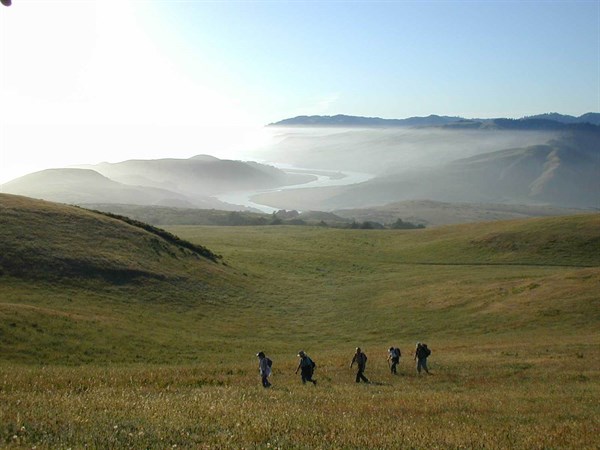
September 24th, 11am-3pm, Gold Ridge RCD, Stewards of the Coast and Redwoods and California State Parks will host a public tour of the Willow Creek watershed. Our tour of one of Sonoma County's most beautiful natural landscapes will focus on native Pomo life, improvements to salmon habitat in Willow Creek and the dramatic connection between upland forest and sea. Watershed health, local ecology and the checkered history of the watershed will be discussed as we drive to the site and hike the canyons.


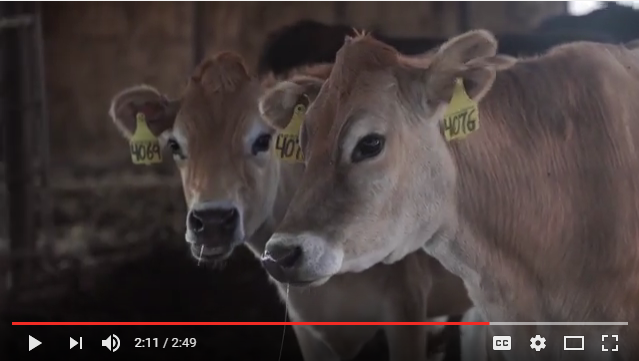

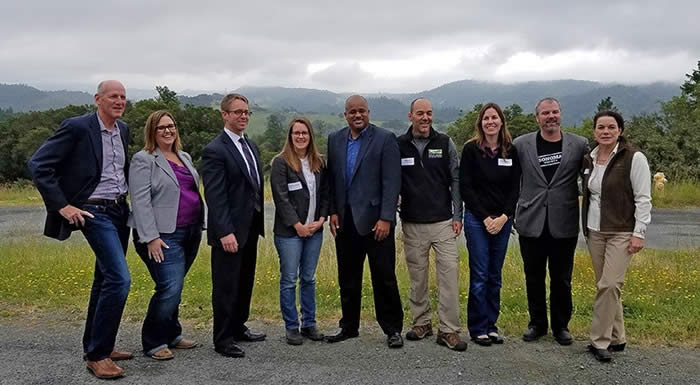
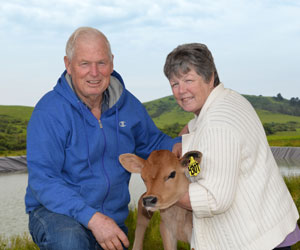 The Sonoma County Farm Bureau awarded Richard and Marilyn Hughes of Westview Jersey Dairy in Bodega, CA, the Luther Burbank Conservation Award for their conservation efforts. The Hughes have converted their Jersey herd to organic, practiced non-tillage pasture management, and recently installed a 1.4 million gallon rainwater catchment pond to conserve water for Salmon Creek's wildlife and human communities. Richard also serves on the Gold Ridge RCD Board of Directors. We are lucky to have his guidance. Congratulations to Richard and Marilyn for their much deserved distinction.
The Sonoma County Farm Bureau awarded Richard and Marilyn Hughes of Westview Jersey Dairy in Bodega, CA, the Luther Burbank Conservation Award for their conservation efforts. The Hughes have converted their Jersey herd to organic, practiced non-tillage pasture management, and recently installed a 1.4 million gallon rainwater catchment pond to conserve water for Salmon Creek's wildlife and human communities. Richard also serves on the Gold Ridge RCD Board of Directors. We are lucky to have his guidance. Congratulations to Richard and Marilyn for their much deserved distinction. 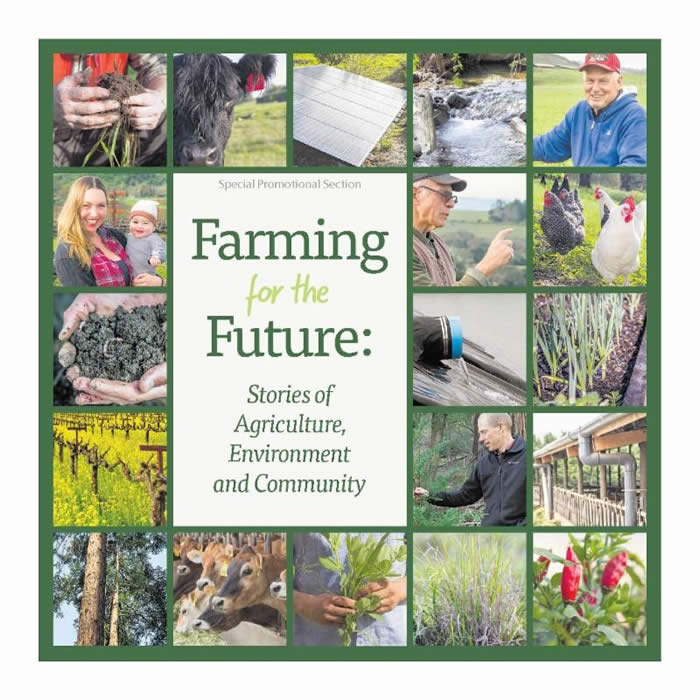 In April 2016, the Sonoma RCD in partnership with Gold Ridge RCD, USDA-NRCS, Sonoma County Farm Bureau, Sonoma County Agricultural Preservation and Open Space District, Sonoma County Winegrape Commission, and UCCE released a collaborative standalone insert in the North Bay Business Journal and Press Democrat, illustrating the stories from the land. Highlighting the agricultural heritage of Sonoma County and the phenomenal stewardship efforts of our local landowners to conserve, restore and protect our natural resources while driving our local economy, supporting our local food system, and providing for the next generation. "We are honored to work in partnership with many innovative stewards of the land who help to protect the beauty and bounty of Sonoma County."
In April 2016, the Sonoma RCD in partnership with Gold Ridge RCD, USDA-NRCS, Sonoma County Farm Bureau, Sonoma County Agricultural Preservation and Open Space District, Sonoma County Winegrape Commission, and UCCE released a collaborative standalone insert in the North Bay Business Journal and Press Democrat, illustrating the stories from the land. Highlighting the agricultural heritage of Sonoma County and the phenomenal stewardship efforts of our local landowners to conserve, restore and protect our natural resources while driving our local economy, supporting our local food system, and providing for the next generation. "We are honored to work in partnership with many innovative stewards of the land who help to protect the beauty and bounty of Sonoma County." 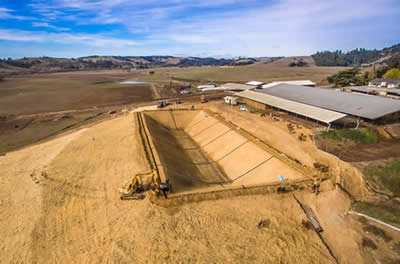 One of the year’s largest construction projects is the Salmon Creek Dairy Water Conservation Project on the Westview Jerseys Organic Dairy operated by Richard and Marilyn Hughes in the Salmon Creek Watershed. Dairies are currently both significant water users, forced to draw from sources influencing riparian flows, and integral contributors to the agriculture-based economy of their surrounding communities. This project further advances the RCD’s expanding water conservation program: our goal is to provide immediate benefits to riparian systems while advancing technologies to prepare our communities for a future that has less predictable rainfall patterns.
One of the year’s largest construction projects is the Salmon Creek Dairy Water Conservation Project on the Westview Jerseys Organic Dairy operated by Richard and Marilyn Hughes in the Salmon Creek Watershed. Dairies are currently both significant water users, forced to draw from sources influencing riparian flows, and integral contributors to the agriculture-based economy of their surrounding communities. This project further advances the RCD’s expanding water conservation program: our goal is to provide immediate benefits to riparian systems while advancing technologies to prepare our communities for a future that has less predictable rainfall patterns. 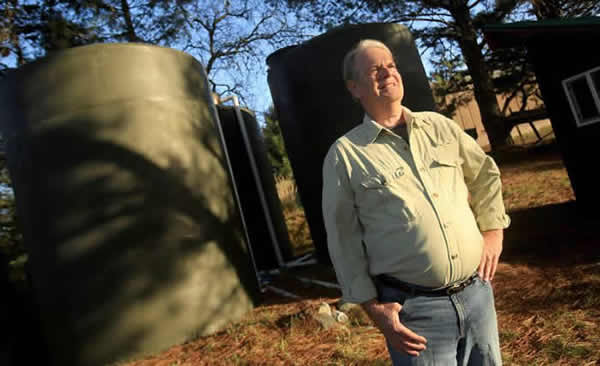 By Guy Kovner for Press Democrat, December 28, 2015
By Guy Kovner for Press Democrat, December 28, 2015  By Guy Kovner for Press Democrat, Sept 7, 2015
By Guy Kovner for Press Democrat, Sept 7, 2015